(As a foreword: This is a ramble, an exploration of a topic, or--following the theme of this blog--a pile of thought-crumbs. I’ve tried to organize it and coherently explain what I’ve been mulling over, but this is not a well-structured, water-tight argument about anything. I’d love to hear what your thoughts are—they may be much more well-formed than mine!)
I recently went to the Center for Puppetry Arts in Atlanta to see this year’s Xperimental Puppetry Theater. I’d always been interested in the idea of a non-children, “18+ only” puppet show, and I personally see puppetry as one of those art forms with a lot of potential of which few people actually take advantage. (For some reason—possibly because it’s just always been that way?—art forms like this often devolve into bad comedy and kitsch. Another example of this is musicals—amazing things can be done in this form, but, in my opinion, they rarely are.)
 |
| Picasso the Gorilla, made by Julia Hill and Brandon Ross, performed at this year's XPT |
The show was an interesting collection of various artists’ short live performances and films. It bounced between a kids’ show gone wrong, claymations of people flying out of windows, images of horror as Death expanded from what was once a pile of plastic trash bags, and a piece in which sensors on puppets mapped shapes onto the digital screen of abstract art that was floating behind them.
The part that really caught my imagination, though, was the film The Wind Up Boy, directed by Beau Brown and Darrell C. Hazelrig. In this live-action film, an old man finds a life-sized wind-up boy figurine that looks like an antique toy. After turning the wind-up key and finding that nothing happens, the man heads away, returns, and finds the wind-up boy in another room, looking at family photographs. When the boy turns towards him, the man’s first reaction is to pick up a fire poker and make to bash in the boy’s skull. Fortunately, he realizes that the boy only wants to hug him, and a heart-warming relationship ensues.
 |
| movie poster for The Wind Up Boy |
At that point in the film, though, I latched onto the feeling of horror that the man—and, surely, the rest of the audience—felt when the boy “came to life.” If you were in his situation, wouldn’t your first, gut reaction be to destroy that thing? Wouldn’t that be your first, gut reaction to any humanoid, man-made thing taking on a life of its own?
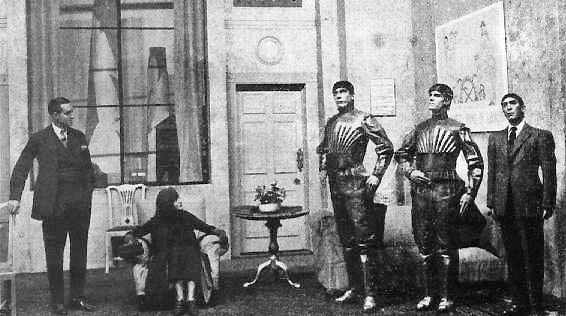 |
| a scene from R.U.R. |
It reminded me of a little internet blurb I saw back in January, celebrating the 90th birthday of the word “robot.” In 1921, a Czech play called R.U.R., or Rossum’s Universal Robots, was the first documented use of the word, which is rooted in the Czech word robota, meaning “servitude, forced labor, or drudgery,” and is in turn rooted in rab, meaning “slave.” The play’s set in a factory that produces artificial people, called “robots,” which work for humans. The robots are unhappy with their situation, so they organize, rebel, and kill all of the world’s humans but one. Wikipedia does a good job of fleshing out the whole piece in greater detail. The play—like all good science fiction—really runs as a metaphor for movements in contemporary human society. But what I find really interesting out of all this is that the word “robot” has been closely linked to the fear of rebellion since its very creation!
 |
| The Tin Man |
I mentioned this to a friend of mine. He’s familiar with R.U.R., but he pointed out that the play can only be credited with the creation of the word “robot.” Together, we started brainstorming examples of inanimate-turned-animate humanoid creations that go back much further than that.
The tin man appeared in the book Wizard of Oz in 1900, rusted to immobility and unhappy with his lot in life. Although he didn’t set up a blood vendetta against the people who did this to him, he did abandon his post in search of something more.
Before modern machines were widespread, though, the stories contained what can be classified as “organic robots.” *
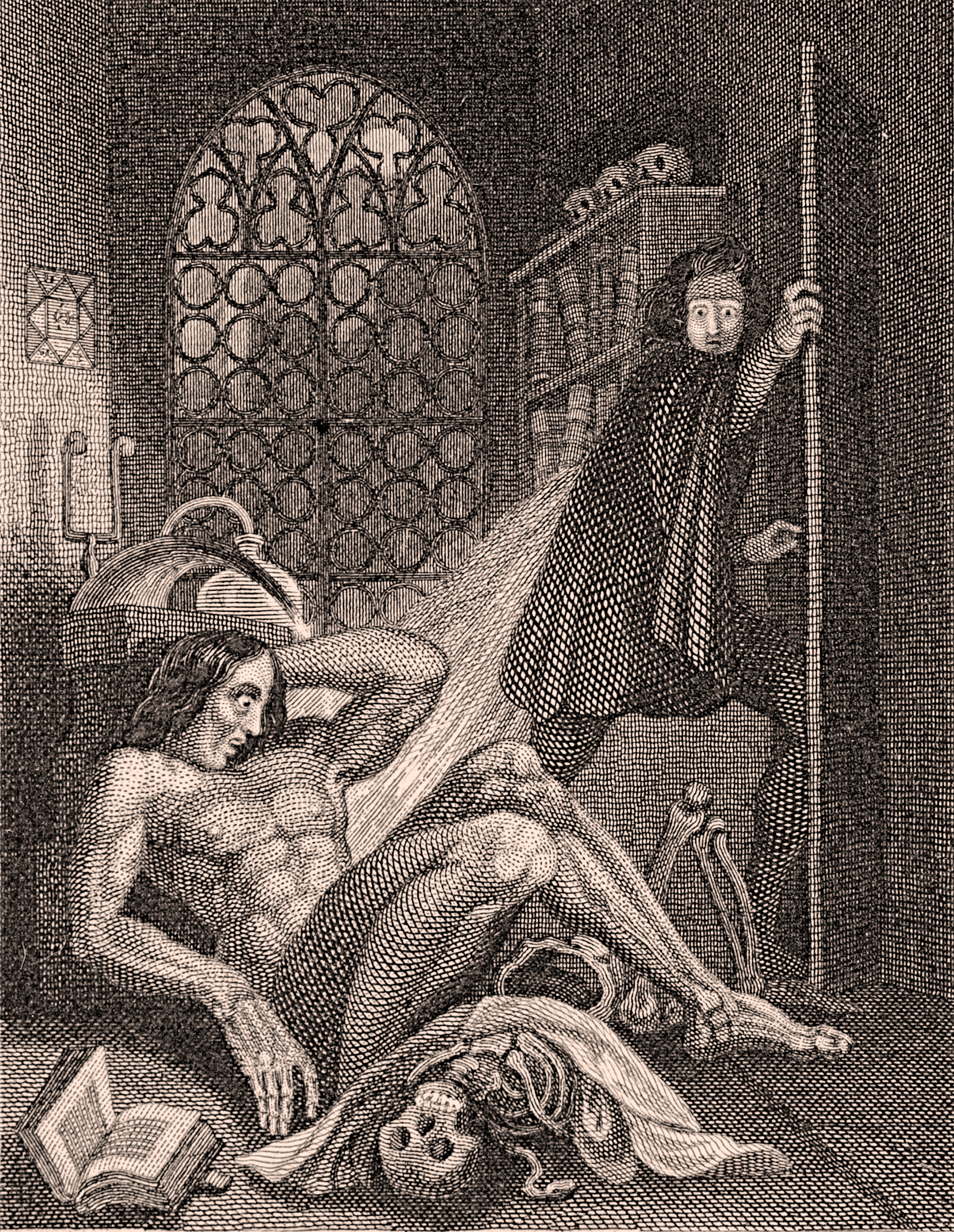 |
| frontspiece to the 1831 edition of Frankenstein |
In 1818, Mary Shelley published the now-infamous story in which Frankenstein plays God and assembles a monster from various human (and possibly animal) body parts. This monster is fully sentient, and he ends up educated and self-aware, but he is so hideous that he is rejected from society and eventually vows revenge against his creator.
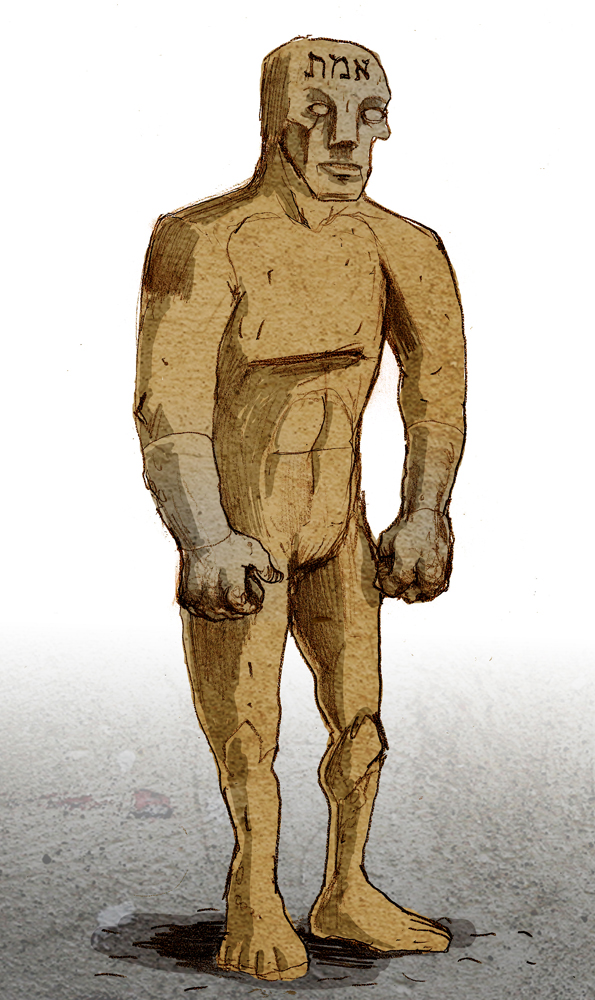 |
| Golem, Wikimedia Commons |
Jewish folklore contains the legend of the golem, a man sculpted from inanimate material (usually clay) and animated through the power of the word—by writing something on his forehead or placing inscribed parchment in his mouth. (I’m incredibly interested in the power of the word—in stories and in everyday life—but that’s another rant for another time!) The creation of a golem often brings trouble on the creator, however. In the most famous golem story, a rabbi in the Jewish ghetto in Prague created a golem to do chores in the synagogue and/or to defend the Jews against attack, but his golem turned mutinous and violent, so the rabbi had to deactivate him. I had the pleasure of touring the synagogue where this story is said to have played out—the body of the golem is supposedly still in the building’s attic.
And wait—while we’re on the topic of people being made out of clay, it wouldn’t be right to forget about Adam and Eve, a couple of activated clay people who eventually turned against their creator! Sorry if my casual description of the story offends anyone—I just want to make the point that this storyline is a major, very important one that has run through many cultures for a much, much longer time than any of us could imagine. (In fact, that is the human creation myth with which I’m most familiar—I’m confident there are other ones that are remarkably similar.)
I have vague memories of other stories in this vein, whether or not the creations end up rebelling. I recall an illustration of a Brothers Grimm or Hans Christian Andersen story, showing a statue morphing into a beautiful woman and twisting around to kiss her sculptor. I’m also almost certain that the story appeared in the Greek mythology I studied in college. And voodoo would definitely have a thing or two to say on the topic of activating inanimate humanoids… If anyone could help me recall these—or any other—examples, I'd be really interested to hear it.
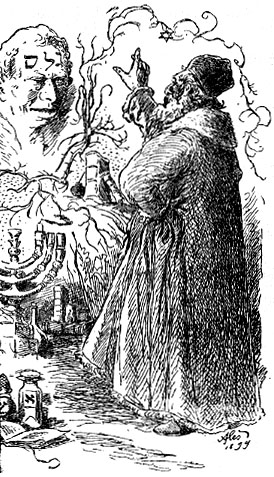 |
| the golem and Rabbi Loew |
So we, as humans, seem to be really fascinated with and really fearful of the idea that some humanoid thing might come to life and turn against us. It feels like this story runs so very, very far back that it’s rooted in that period of human existence before we convinced ourselves that the world is a rational, scientifically-explained place to live. It’s rooted in that period during which anything could—and, for some perhaps, anything did--happen. It’s rooted in that period during which tall tales were just as prevalent and possibly just as credible as small, everyday observations.** During this period, we were willing to believe a lot, and there are many core beliefs and superstitions that we carried long, long into the “Age of Reason.”
Almost all of those beliefs and superstitions died out. But why do we carry this gut-reaction fear of non-human humans in ourselves still today?
My brother thinks that the only thing we fear in this instance is something unknown. We have evolved the trait to be wary of the unknown. This makes sense: those of us who weren’t cautious of the unknown died before they could reproduce. And, since we’ve never actually encountered a self-aware puppet moving to the next room, we get the heebie-jeebies when we see it on the big screen.
There’s obviously also the fear of what we can’t control. We’ve been at war with other (predatory) elements of the natural world forever and ever. We’ve been at war with the Entire Natural World since, perhaps, the Roman Empire, would you say? We’ve wanted to control it. We’ve wanted to control everything. And we’re really unsettled by the things we can’t control.
But I want to go out on a limb and say that we are more directly fearful of humanoid things we can’t control than of uncontrollable things that do not resemble us.
I’ll insert an anecdote here: When I was a teenager, I went on several-weeks-long backpacking trips during a couple of summers instead of going to the classic American summer camp. One fairly dark night, the leaders had each of us head along the trail completely alone for about fifteen minutes. They didn’t explain what they wanted us to get out of it beforehand. Discussing the experience with the others afterwards, though, one thing stuck out in my head: whenever any of us jumped at creepy shadows or oddly-shaped bushes along the way, it was always because they took on the shapes of people. Always--even though we were in the middle of nowhere and had just as much logical reason to be fearful of bears as of other people. It was just that we were used to civilization, and we had trained ourselves to find the patterns that resembled other people. Other people were all we were really familiar with, and all we had really been raised to fear.
I think that we—at least, we Westerners—have tamed the world we know by killing off or driving away anything that is likely to harm us.*** At this point, the only thing we really, consciously, feel we need to fear is each other. And, funnily enough, those things our guts fear most are those that might have the same capacities as us.
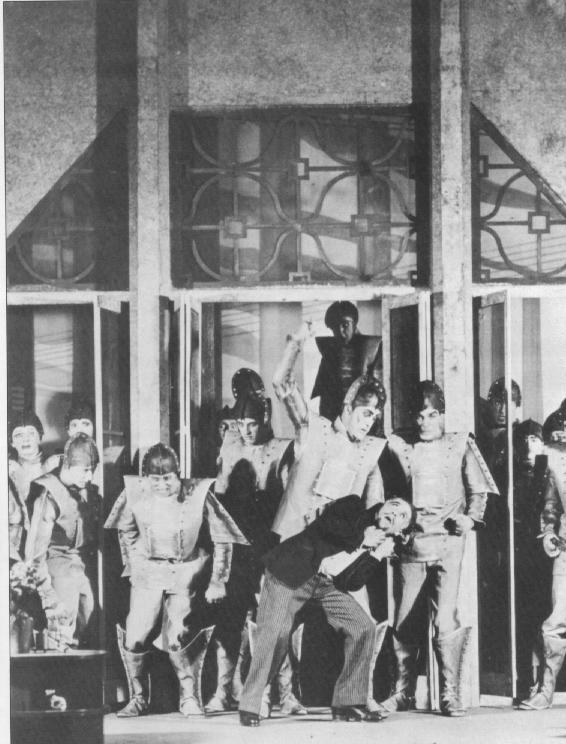 |
| a scene from R.U.R. |
* In R.U.R., the robots were also organic, being constructed out of manufactured human organs. What I’m saying here is that there was a point on this timeline in which our modern, stereotypical image of metallic, gear-and-electricity-based “robots” appears, but that does not change the story itself significantly.
** I am thinking of Philibín Ó Súilleabháin Beara’s The Natural History of Ireland, written in the early 1600s, in which he describes all of the flora, fauna, geological features, etc. on the island as scientifically as possible. In the midst of it, as logically-minded as ever, he explains that there are two lakes on either side of the land. If you insert the branch of a hazel tree into one, it turns into the branch of an ash tree. The other lake turns an ash branch into a hazel branch. He also talks about water horses, which reportedly look just like land horses but that live underwater. Again, to the author, this is as logical an account of the features of Ireland as anything else.
*** The weather is another story, but it’s also on another scale. I feel like the “creeped out” feeling I’m discussing can’t apply to forest fires and floods.